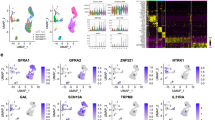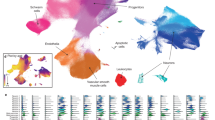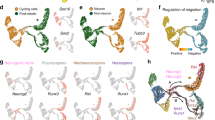Abstract
The primary sensory system requires the integrated function of multiple cell types, although its full complexity remains unclear. We used comprehensive transcriptome analysis of 622 single mouse neurons to classify them in an unbiased manner, independent of any a priori knowledge of sensory subtypes. Our results reveal eleven types: three distinct low-threshold mechanoreceptive neurons, two proprioceptive, and six principal types of thermosensitive, itch sensitive, type C low-threshold mechanosensitive and nociceptive neurons with markedly different molecular and operational properties. Confirming previously anticipated major neuronal types, our results also classify and provide markers for new, functionally distinct subtypes. For example, our results suggest that itching during inflammatory skin diseases such as atopic dermatitis is linked to a distinct itch-generating type. We demonstrate single-cell RNA-seq as an effective strategy for dissecting sensory responsive cells into distinct neuronal types. The resulting catalog illustrates the diversity of sensory types and the cellular complexity underlying somatic sensation.
This is a preview of subscription content, access via your institution
Access options
Subscribe to this journal
Receive 12 print issues and online access
$209.00 per year
only $17.42 per issue
Buy this article
- Purchase on Springer Link
- Instant access to full article PDF
Prices may be subject to local taxes which are calculated during checkout





Similar content being viewed by others
Accession codes
References
Ma, Q. Population coding of somatic sensations. Neurosci. Bull. 28, 91–99 (2012).
Ma, Q. Labeled lines meet and talk: population coding of somatic sensations. J. Clin. Invest. 120, 3773–3778 (2010).
Shapiro, E., Biezuner, T. & Linnarsson, S. Single-cell sequencing-based technologies will revolutionize whole-organism science. Nat. Rev. Genet. 14, 618–630 (2013).
Wichterle, H., Gifford, D. & Mazzoni, E. Neuroscience. Mapping neuronal diversity one cell at a time. Science 341, 726–727 (2013).
Islam, S. et al. Characterization of the single-cell transcriptional landscape by highly multiplex RNA-seq. Genome Res. 21, 1160–1167 (2011).
Jaitin, D.A. et al. Massively parallel single-cell RNA-seq for marker-free decomposition of tissues into cell types. Science 343, 776–779 (2014).
Treutlein, B. et al. Reconstructing lineage hierarchies of the distal lung epithelium using single-cell RNA-seq. Nature 509, 371–375 (2014).
Lallemend, F. & Ernfors, P. Molecular interactions underlying the specification of sensory neurons. Trends Neurosci. 35, 373–381 (2012).
Li, L. et al. The functional organization of cutaneous low-threshold mechanosensory neurons. Cell 147, 1615–1627 (2011).
Liu, Y. & Ma, Q. Generation of somatic sensory neuron diversity and implications on sensory coding. Curr. Opin. Neurobiol. 21, 52–60 (2011).
Andres, K.H. Z. Zellforsch. Mikrosk. Anat. [Research on the fine-structure of spinal ganglia] 55, 1–48 (1961).
Lieberman, A.R. Sensory ganglia. in The Peripheral Nerve (ed. Landon, D.N.) 188–278 (Chapman and Hall, London, 1976).
McMahon, S.B., Armanini, M.P., Ling, L.H. & Phillips, H.S. Expression and coexpression of Trk receptors in subpopulations of adult primary sensory neurons projecting to identified peripheral targets. Neuron 12, 1161–1171 (1994).
Kharchenko, P.V., Silberstein, L. & Scadden, D.T. Bayesian approach to single-cell differential expression analysis. Nat. Methods 11, 740–742 (2014).
Woolf, C.J. & Ma, Q. Nociceptors–noxious stimulus detectors. Neuron 55, 353–364 (2007).
Abdo, H. et al. Dependence on the transcription factor Shox2 for specification of sensory neurons conveying discriminative touch. Eur. J. Neurosci. 34, 1529–1541 (2011).
Bourane, S. et al. Low-threshold mechanoreceptor subtypes selectively express MafA and are specified by Ret signaling. Neuron 64, 857–870 (2009).
Gascon, E. et al. Hepatocyte growth factor-Met signaling is required for Runx1 extinction and peptidergic differentiation in primary nociceptive neurons. J. Neurosci. 30, 12414–12423 (2010).
Luo, W., Enomoto, H., Rice, F.L., Milbrandt, J. & Ginty, D.D. Molecular identification of rapidly adapting mechanoreceptors and their developmental dependence on ret signaling. Neuron 64, 841–856 (2009).
Wende, H. et al. The transcription factor c-Maf controls touch receptor development and function. Science 335, 1373–1376 (2012).
Ernfors, P., Lee, K.F., Kucera, J. & Jaenisch, R. Lack of neurotrophin-3 leads to deficiencies in the peripheral nervous system and loss of limb proprioceptive afferents. Cell 77, 503–512 (1994).
Chen, C.L. et al. Runx1 determines nociceptive sensory neuron phenotype and is required for thermal and neuropathic pain. Neuron 49, 365–377 (2006).
Luo, W. et al. A hierarchical NGF signaling cascade controls Ret-dependent and Ret-independent events during development of nonpeptidergic DRG neurons. Neuron 54, 739–754 (2007).
Snider, W.D. & McMahon, S.B. Tackling pain at the source: new ideas about nociceptors. Neuron 20, 629–632 (1998).
Han, L. et al. A subpopulation of nociceptors specifically linked to itch. Nat. Neurosci. 16, 174–182 (2013).
Liu, Q. et al. Sensory neuron-specific GPCR Mrgprs are itch receptors mediating chloroquine-induced pruritus. Cell 139, 1353–1365 (2009).
Caterina, M.J., Rosen, T.A., Tominaga, M., Brake, A.J. & Julius, D. A capsaicin-receptor homologue with a high threshold for noxious heat. Nature 398, 436–441 (1999).
McKemy, D.D., Neuhausser, W.M. & Julius, D. Identification of a cold receptor reveals a general role for TRP channels in thermosensation. Nature 416, 52–58 (2002).
Tominaga, M. et al. The cloned capsaicin receptor integrates multiple pain-producing stimuli. Neuron 21, 531–543 (1998).
Coste, B. et al. Piezo1 and Piezo2 are essential components of distinct mechanically activated cation channels. Science 330, 55–60 (2010).
Seal, R.P. et al. Injury-induced mechanical hypersensitivity requires C-low threshold mechanoreceptors. Nature 462, 651–655 (2009).
Peier, A.M. et al. A TRP channel that senses cold stimuli and menthol. Cell 108, 705–715 (2002).
Vriens, J. et al. TRPM3 is a nociceptor channel involved in the detection of noxious heat. Neuron 70, 482–494 (2011).
Chi, X.X. & Nicol, G.D. The sphingosine 1-phosphate receptor, S1PR1, plays a prominent but not exclusive role in enhancing the excitability of sensory neurons. J. Neurophysiol. 104, 2741–2748 (2010).
Doyle, T., Finley, A., Chen, Z. & Salvemini, D. Role for peroxynitrite in sphingosine-1-phosphate-induced hyperalgesia in rats. Pain 152, 643–648 (2011).
Welch, S.P., Sim-Selley, L.J. & Selley, D.E. Sphingosine-1-phosphate receptors as emerging targets for treatment of pain. Biochem. Pharmacol. 84, 1551–1562 (2012).
Kremer, A.E. et al. Lysophosphatidic acid is a potential mediator of cholestatic pruritus. Gastroenterology 139, 1008–1018 (2010).
Ueda, H., Matsunaga, H., Olaposi, O.I. & Nagai, J. Lysophosphatidic acid: chemical signature of neuropathic pain. Biochim. Biophys. Acta 1831, 61–73 (2013).
Smith, M.T., Woodruff, T.M., Wyse, B.D., Muralidharan, A. & Walther, T. A small molecule angiotensin II type 2 receptor (AT2R) antagonist produces analgesia in a rat model of neuropathic pain by inhibition of p38 mitogen-activated protein kinase (MAPK) and p44/p42 MAPK activation in the dorsal root ganglia. Pain Med. 14, 1557–1568 (2013).
Dobner, P.R. Neurotensin and pain modulation. Peptides 27, 2405–2414 (2006).
Wilson, S.R. et al. TRPA1 is required for histamine-independent, Mas-related G protein-coupled receptor-mediated itch. Nat. Neurosci. 14, 595–602 (2011).
Han, S.K., Mancino, V. & Simon, M.I. Phospholipase Cβ 3 mediates the scratching response activated by the histamine H1 receptor on C-fiber nociceptive neurons. Neuron 52, 691–703 (2006).
Imamachi, N. et al. TRPV1-expressing primary afferents generate behavioral responses to pruritogens via multiple mechanisms. Proc. Natl. Acad. Sci. USA 106, 11330–11335 (2009).
Angelova-Fischer, I. & Tsankov, N. Successful treatment of severe atopic dermatitis with cysteinyl leukotriene receptor antagonist montelukast. Acta Dermatovenerol. Alp. Pannonica Adriat. 14, 115–119 (2005).
Sonkoly, E. et al. IL-31: a new link between T cells and pruritus in atopic skin inflammation. J. Allergy Clin. Immunol. 117, 411–417 (2006).
Mishra, S.K. & Hoon, M.A. The cells and circuitry for itch responses in mice. Science 340, 968–971 (2013).
Sun, Y.G. et al. Cellular basis of itch sensation. Science 325, 1531–1534 (2009).
Sun, Y.G. & Chen, Z.F. A gastrin-releasing peptide receptor mediates the itch sensation in the spinal cord. Nature 448, 700–703 (2007).
Liu, X.Y. et al. B-type natriuretic peptide is neither itch-specific nor functions upstream of the GRP-GRPR signaling pathway. Mol. Pain 10, 4 (2014).
Goswami, S.C. et al. Itch-associated peptides: RNA-Seq and bioinformatic analysis of natriuretic precursor peptide B and gastrin releasing peptide in dorsal root and trigeminal ganglia, and the spinal cord. Mol. Pain 10, 44 (2014).
Usoskin, D. et al. En masse in vitro functional profiling of the axonal mechanosensitivity of sensory neurons. Proc. Natl. Acad. Sci. USA 107, 16336–16341 (2010).
Hjerling-Leffler, J., Alqatari, M., Ernfors, P. & Koltzenburg, M. Emergence of functional sensory subtypes as defined by transient receptor potential channel expression. J. Neurosci. 27, 2435–2443 (2007).
Islam, S. et al. Highly multiplexed and strand-specific single-cell RNA 5′ end sequencing. Nat. Protoc. 7, 813–828 (2012).
Shannon, P. et al. Cytoscape: a software environment for integrated models of biomolecular interaction networks. Genome Res. 13, 2498–2504 (2003).
Bindea, G. et al. ClueGO: a Cytoscape plug-in to decipher functionally grouped gene ontology and pathway annotation networks. Bioinformatics 25, 1091–1093 (2009).
Liu, T. & Ji, R.R. New insights into the mechanisms of itch: are pain and itch controlled by distinct mechanisms? Pflugers Arch. 465, 1671–1685 (2013).
Furlan, A., Lubke, M., Adameyko, I., Lallemend, F. & Ernfors, P. The transcription factor Hmx1 and growth factor receptor activities control sympathetic neurons diversification. EMBO J. 32, 1613–1625 (2013).
Acknowledgements
The authors thank the CLICK Imaging Facility, supported by the Wallenberg Foundation. This work was supported by the Swedish Research Council for Medicine and Health, the Swedish Foundation for Strategic Research and Linné grants (DBRM grants), the Swedish Brain Foundation, Hållsten Foundation, Torsten Söderberg Foundation, Wallenberg Scholar and European Research Council advanced grant (232675) to P.E.; and by European Research Council starting grant (261063) to S.L.
Author information
Authors and Affiliations
Contributions
D.U., S.L. and P.E. designed the study. D.U., A.F., D.L., O.K., H.A., J.H.-L., J.H. and S.I. carried out experiments. D.U., P.V.K., P.L., P.E. and S.L. performed data analysis, including statistical analyses. D.U., S.L. and P.E. wrote the manuscript in consultation with all authors.
Corresponding authors
Ethics declarations
Competing interests
The authors declare no competing financial interests.
Integrated supplementary information
Supplementary Figure 1 Number of genes detected.
Distribution of the number of detected genes, including only the UCSC mRNA gene models (i.e. excluding many non-coding RNAs, ribosomal and tRNAs and expressed repeat families). The average number of detected genes was 3574 (standard deviation, 2010).
Supplementary Figure 2 Immunohistochemical identification of neuronal types.
(a) Triple immunohistochemistry for LDHB, TRKB and TRKC and ISLET1. Note TRKB+-TRKC+/LDHB+ neurons (inset). All neurons belonging to the large Neurofilament, heavy polypeptide neuron class express Lactate dehydrogenase B (Ldhb). (b-e) Validation of the NF1 and NF2 TRKB+ subgroups. (b) Triple immunohistochemistry for CACNA1H, TRKB and ISLET1. Note TRKB+/CACNA1H+ neurons (inset). The Calcium channel, voltage-dependent, T type, alpha 1H subunit (CACNA1H) labels most of the neurotrophic tyrosine kinase, receptor, type 2, TRKB-expressing neurons. (c) Triple immunohistochemistry for NECAB2, TRKB and ISLET1. Note NECAB2+/TRKBhigh neurons (inset). The NF1 subgroup of neurons expresses the N-terminal EF-hand calcium binding protein 2 (NECAB2) and TRKB at high levels (TRKBhigh). (d) Triple immunohistochemistry for CALB1, TRKB and ISLET1. Note CALB1+/TRKBlow (inset). The NF2 subgroup expresses Calbindin (CALB1) and TRKB at low levels (TRKBlow, NF2). (e) Triple immunohistochemistry for NECAB2, CALB1 and ISLET1 shows NECAB2 and CALB1 being mutually exclusive (inset). (f-j) Validation of the NF3, NF4 and NF5 TRKC+ subgroups. The large, Neurotrophic tyrosine kinase, receptor, type 3 (TRKC) population is formed by 3 subgroups. (f) Triple immunohistochemistry for FAM19A1, TRKC and ISLET1. Note FAM19A1+/TRKC+ neurons (inset) and TRKC+/FAM19A1- neurons (arrowheads). NF3 is defined as a subpopulation of TRKC neurons expressing the Chemokine-like protein TAFA-1 (FAM19A1). (g) Triple immunohistochemistry for FAM19A1, Parvalbumin (PV) and ISLET1. Pvalb and Fam19a1 expression is mutually exclusive (inset). NF3 neurons are negative for Parvalbumin. (h) Triple immunohistochemistry for CNTNAP2, PV and ISLET1. Note PV+/CNTNAP2+ neurons (inset). (i) Triple immunohistochemistry for SPP1, CNTNAP2 and ISLET1. Note SPP1+/CNTNAP2+ neurons (inset) representing NF4 and NF5. NF4 and NF5 PV-positive neurons are a subpopulation of TRKC-positive neurons. (j) Triple immunohistochemistry for TRKC, CNTNAP2 and ISLET1. Note NF4 and NF5 CNTNAP2+/TRKC+ neurons (inset), subgroups of the largest TRKC population. We could not distinguish NF4 from NF5. However, Inhibin, beta B (INHBB) stood out as a good candidate to mark neurons belonging to the NF5 subgroup of TRKC+/PV+ neurons. (k) Triple immunohistochemistry for TH (sole marker defining TH population), combined TRKA/PLXNC1/NEFH and ISLET1. Note TH+/TRKA-/PLXNC1-/NEFH- neurons (inset). TH labels neither neurons belonging to the NF group (defined by Nefh expression), nor the NP group (defined by Plxnc1 expression) or the PEP group (defined by TrkA). (l-v) A combinatorial immunohistochemistry strategy was used to successfully distinguish the NP (l-p, v) and the PEP (q-u) classes of sensory neurons. Data analysis identified Plexin C1 (PLXNC1) as a common marker for all three subgroups of the NP group and, additionally, being expressed in some PEP1 neurons. (l) Triple immunohistochemistry for P2X3, PLXNC1 and SST. Note SST+/PLXNC1+/P2X3+ (inset). PLXNC1 labels all Somatostatin (SST) positive neurons belonging to NP3 and P2X3+ neurons belonging to NP1. (m) Triple immunohistochemistry for combined FAM19A1/TAC1, PLXNC1 and SST. Note (FAM19A1+ or TAC1+)/PLXNC1+/SST- (arrowheads) and (FAM19A1- and TAC1-) /PLXNC1+/SST+ neurons (inset). PLXNC1 expression is detected in NP3 and some neurons belonging to PEP groups. (n) Triple immunohistochemistry for FAM19A1, PLXNC1 and CGRP. Fam19a1 and Plxnc1 expression is mutually exclusive (inset); PEP2 neurons do not express PLXNC1 (o) Triple immunohistochemistry for TAC1, PLXNC1 and CGRP. Note TAC1+/PLXNC1+/ CGRP+ neurons (inset); expression patterns of PLXNC1 and of Tachykinin, precursor 1 (TAC1), a unique marker of PEP1 neurons, show some overlap. (p) Triple immunohistochemistry for PLXNC1, combined FAM19A1 and TAC1 and CGRP, shows CGRP+/FAM19A1-TAC1-/PLXNC1+ neurons belonging to the NP2 subgroup. (q) Triple immunohistochemistry for CGRP, TRKA and ISLET1. TRKA and CGRP show 1:1 co-localization (inset). The Neurotrophic tyrosine kinase, receptor, type 1 (TRKA) and Calcitonin receptor-like (CGRP) are expressed by all neurons belonging to NP2, PEP1 and PEP2 subgroups. (r) Triple immunohistochemistry for TAC1, TRKA and ISLET1. TAC1 defines PEP1 neurons. Note TRKA+/TAC1+ (inset) and TRKA+/TAC1- neurons (arrowheads) belonging to the other two TRKA-expressing groups, NP2 and PEP2, respectively. (s) Triple immunohistochemistry for FAM19A1, TRKA and NEFH. Note NEFH+/FAM19A1+/ TRKA+ and NEFH+/FAM19A1+/ TRKA- neurons, belonging to PEP2 and NF3, respectively (inset) and TRKA+/FAM19A1- neurons (arrowheads) belonging to the other two TRKA-expressing groups (NP2 and PEP1). (t) Triple immunohistochemistry for combined FAM19A1/TAC1, TRKA and ISLET1. Note TRKA+/FAM19A1-/TAC1- neurons (inset and arrowheads), belonging to NP2 subgroup. (u) Triple immunohistochemistry for SST, TRKA and ISLET1. Sst and TrkA expression is mutually exclusive (inset). Sst defines the NP3 subgroup. (v) Double immunohistochemistry for PLXNC1 and combined NFH/TRKA/SST/TH. Note PLXNC1+/NFH-/TRKA-/SST-/TH- neurons belonging to the NP1 subclass. Scale bar = 50 μm.
Supplementary information
Supplementary Text and Figures
Supplementary Figures 1–3 (PDF 964 kb)
Supplementary Table 1
Full lists of genes showing differential expression (fold change and significance) for all eleven individual neuronal types analyzed using the SCDE method against all remaining neurons (pooled) See first worksheet (Tab1-INFO) for detailed legend. (XLSX 14786 kb)
Supplementary Table 2
GO analysis of biological processes for eleven neuronal types To Fig. 2e. See first worksheet (Tab1-INFO) for detailed legend. (XLSX 638 kb)
Supplementary Table 3
Differential expression (fold change and significance) for neuronal versus non-neuronal populations and gene ontology analysis (biological process) distinguishing these two populations See first worksheet (Tab1-INFO) for detailed legend. (XLSX 1886 kb)
Supplementary Table 4
Expression profile (fraction of positive cells, with color coding) for 452 genes (fused 11 lists with top 50 genes enriched in each of neuronal categories, by SCDE method, after redundancy removal; “top 50” list) and all neuronal types. To Fig. 2d. See first worksheet (Tab1-INFO) for detailed legend. (XLSX 67 kb)
Supplementary Table 5
Expression profile (fraction of positive cells, with color coding) of 18 genes (17 picked from “top 50” gene lists (Table S2) and Ntrk3 (TrkC) as extensively used sensory marker) used for in vivo immunohistochemical validation experiments. To Fig. 3. See first worksheet (Tab1-INFO) for detailed legend. (XLSX 17 kb)
Supplementary Table 6
Expression profile (fraction of positive cells, with color coding) for genes participating as operational components (shown in Figure 4a, in the same order) of sensory neurons in the different neuronal types. To Fig. 4a. See first worksheet (Tab1-INFO) for detailed legend. (XLSX 48 kb)
Supplementary Table 7
Expression profile (fraction of positive cells, with color coding) for itch-related and neuropeptide genes in unmyelinated neurons. To Table 1. See first worksheet (Tab1-INFO) for detailed legend. (XLSX 29 kb)
41593_2015_BFnn3881_MOESM19_ESM.avi
3D video for PCA plot of five clusters representing four neuronal and one non-neuronal cell populations shown in Figure 1a (AVI 6221 kb)
Rights and permissions
About this article
Cite this article
Usoskin, D., Furlan, A., Islam, S. et al. Unbiased classification of sensory neuron types by large-scale single-cell RNA sequencing. Nat Neurosci 18, 145–153 (2015). https://doi.org/10.1038/nn.3881
Received:
Accepted:
Published:
Issue Date:
DOI: https://doi.org/10.1038/nn.3881
This article is cited by
-
The kainate receptor GluK2 mediates cold sensing in mice
Nature Neuroscience (2024)
-
Functionally-selective inhibition of threshold sodium currents and excitability in dorsal root ganglion neurons by cannabinol
Communications Biology (2024)
-
Unleashing Axonal Regeneration Capacities: Neuronal and Non-neuronal Changes After Injuries to Dorsal Root Ganglion Neuron Central and Peripheral Axonal Branches
Molecular Neurobiology (2024)
-
ScLSTM: single-cell type detection by siamese recurrent network and hierarchical clustering
BMC Bioinformatics (2023)
-
Follicle-innervating Aδ-low threshold mechanoreceptive neurons form receptive fields through homotypic competition
Neural Development (2023)



